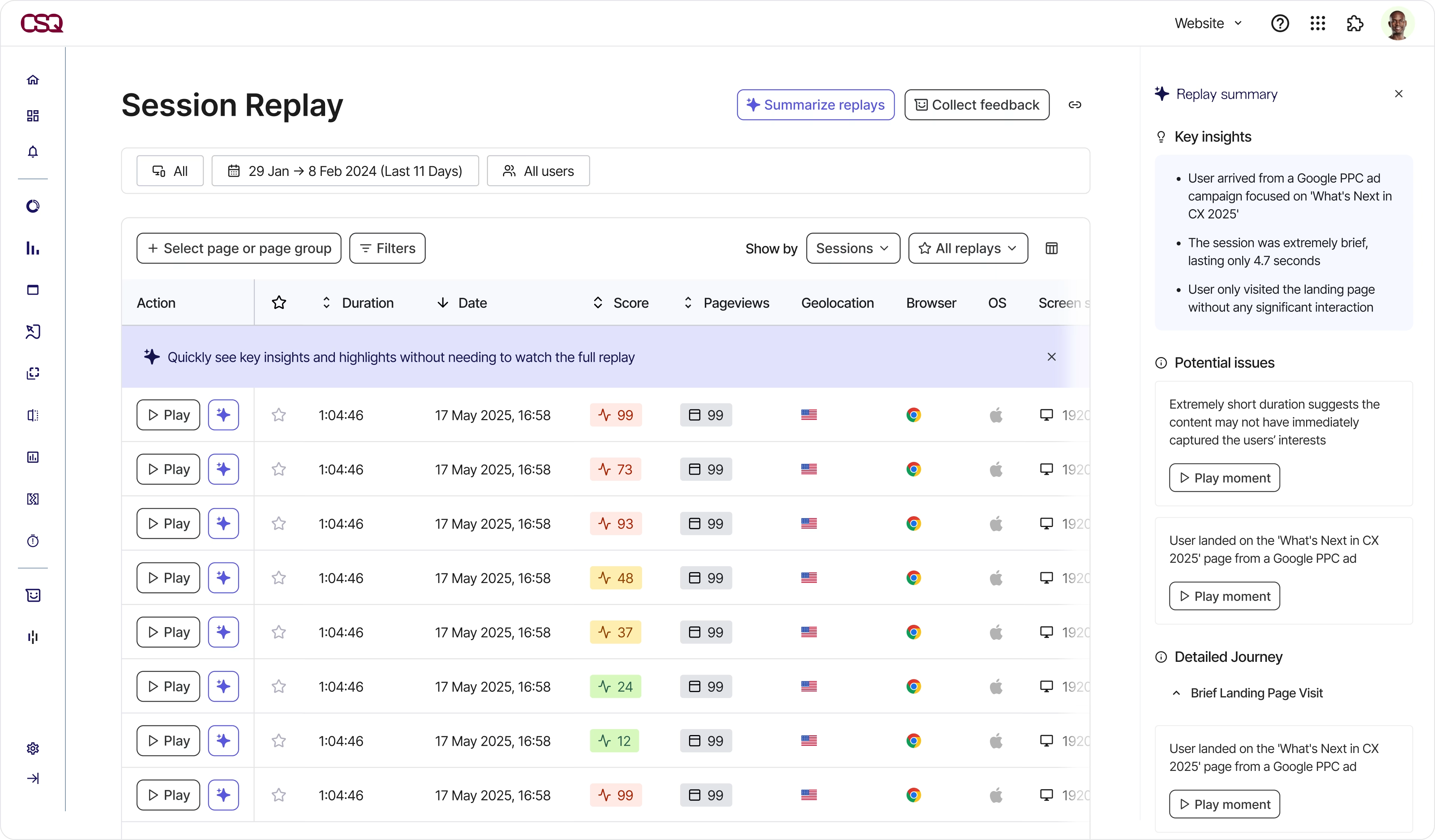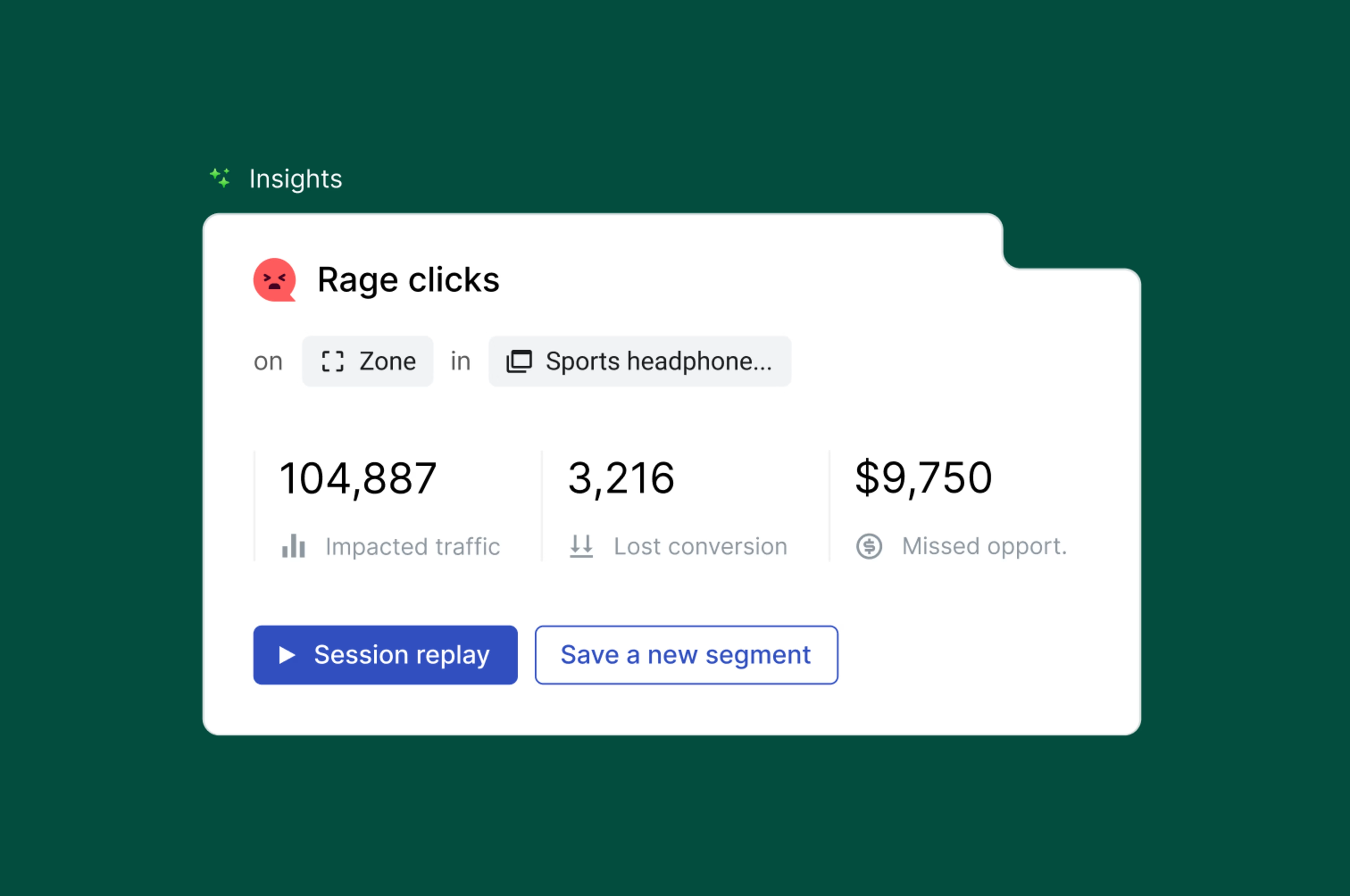Marketing is under pressure from all sides.
Budgets are tighter, conversions are harder to earn, and proving return on investment (ROI) is a constant uphill battle. And most analytics tools are still stuck in the past—built to summarize what happened, not help decide what to do next.
With AI in marketing, that gap is finally closing. Not by replacing human insight, but by removing the friction that slows you down: the hours spent combing through dashboards, the fragmented customer journeys, the reports that miss the bigger picture.
This guide explores how AI marketing analytics gives you real-time clarity, boosts performance across channels, and ties every campaign to measurable impact—without the usual delays or reporting headaches.
Key insights
Traditional metrics can’t keep up with marketer needs. Teams today need more than retrospective reports—they need actionable insights that match the speed and complexity of their campaigns.
AI marketing unlocks real-time understanding of customer behavior. By interpreting live behavioral signals—like frustration, hesitation, or exit intent—AI-powered tools surface insights as they unfold, helping marketers respond faster and smarter.
AI enhances, not replaces, marketing expertise. With platforms like Contentsquare, AI fits into existing marketing workflows, making it easier for marketers to optimize across SEO, social, and email without overhauling how they work. AI adds precision without adding complexity.
What AI brings to marketing: questions to clarity, faster
Most marketing strategies still depend on lagging indicators—click-through rates (CTR), bounce rates, and time on page—to make major campaign decisions. But these metrics just confirm what already happened. They don't reveal customer intent, friction points, or real optimization opportunities.
AI analytics changes that by surfacing behavioral signals like rage clicks, scroll hesitation, and navigation loops in real time, so you can act before performance drops.
Instead of spending hours analyzing dashboards, waiting for data teams, or guessing where your customer journey broke down, using AI tools lets you
Ask the right questions about what's really happening in your marketing campaigns
Get instant answers based on actual user behavior, not assumptions
Act quickly before frustration turns into lost revenue
Whether you're proving campaign ROI, improving ad targeting, or reducing drop-offs on landing pages, AI helps you move from question to insight to action in seconds, powered by AI assistants and algorithms that surface actionable insights from customer behavior patterns.
AI insights let us dive straight into the Contentsquare platform, providing insights without us having to think twice about it and helping us quickly understand where our customers are facing friction or frustration.
5 ways marketers are using AI to work smarter
You don't need to wait for next quarter's strategy refresh to start using AI for marketing. Here are 5 practical approaches marketing teams are implementing right now.
Each of these use cases tackles a common challenge, then shows how AI makes analysis faster, action clearer, and results more measurable.
1. Get instant clarity on what’s hurting campaign performance
The problem: you're driving traffic to a web page, but conversions are flat, bounce rates are high, and your team can't pinpoint why.
You know something's wrong, but is it the content, user experience (UX), or audience targeting?
Analyze it: start with Chat with Sense, Contentsquare's AI copilot. Try asking: "What's different about users who bounce versus those who convert?"
Then use Contentsquare’s AI-powered Session Replay Summaries feature, which automatically clusters user sessions based on behaviors like rage clicks or scroll hesitation. This way, you skip hours of manual review and go straight to the patterns that impact your customer experience.

Contentsquare groups sessions by behaviors, so you can spot critical issues without watching every recording
Use these insights to
Fix friction points before they escalate into major drop-offs
Prioritize development work based on actual user pain points
Reduce wasted ad spend by identifying audiences that don't convert
Share behavior-backed recommendations with design and content creation teams
2. Understand audience behavior in seconds
The problem: you need to understand how different users behave across your site, but traditional reports take too long and miss important nuances.
Understanding how customer segments behave—especially across multiple sessions—is essential for effective targeting and personalized content. But conventional analysis often misses details that drive customer engagement.
Analyze it: ask Sense about how returning users behave differently from new ones.
The AI agent automatically directs you to relevant customer data—from capabilities like Contentsquare’s Journey Analysis—and uncovers patterns that explain performance gaps in customer behavior.
For example, you might discover new visitors drop off early in your conversion funnel, while returning users complete more steps and convert at higher rates.
![[Visual] AI Sense](http://images.ctfassets.net/gwbpo1m641r7/4cqUd79uqdD7WzmQIb7Q7C/a5726634c1c6959527a98f3096d22c09/combined_ai_marketers_graphic.png?w=1920&q=100&fit=fill&fm=avif)
Sense is built for marketers who need fast clarity across web, mobile, and campaigns
Use these insights to
Personalize homepage content and offers for returning visitors
Adjust landing page design to better support new audiences
Build retargeting segments based on actual drop-off patterns
Enhance email marketing with behavior-driven segmentation
💡 Pro tip: AI B2B marketing tools use machine learning algorithms to instantly segment across customer journey stages—perfect for dynamic content creation and ad retargeting campaigns.
3. Spot high-intent users and trigger smarter campaigns in real time
The problem: you want to personalize campaigns, but you're working with surface-level signals like clicks and page views.
Personalization only works when you target the right behavior at the right moment. But most marketing strategies only show who clicked—not who's hesitating, frustrated, or showing genuine purchase intent.
Analyze it: meet Contentsquare’s AI Alerts, a real-time monitoring system that continuously scans your site for signs of friction or opportunity. When it detects patterns like rapid scrolling or repeated exits, it flags them instantly so you can respond while the user is still engaged.

Teams using AI Alerts to flag rage clicks and problematic journeys can optimize experiences as they happen
Pair this with Contentsquare’s AI-powered Surveys capability, which lets you trigger contextual surveys based on specific user behaviors that you define. For example, if a user returns to your pricing page but doesn't convert, you can ask what's holding them back at that point—not days later through generic surveys.
Use these insights to
Trigger real-time responses like exit overlays or personalized offers
Build campaign audiences based on actual on-site behavior
Prioritize retargeting for users showing genuine intent
Address customer support issues before they escalate
How Wolverine Worldwide acted on AI alerts in real time
When Contentsquare’s AI detected a spike in users landing on an error page, Wolverine’s team didn’t wait for a report. They built a segment of affected visitors and created a recovery journey to guide them back on track, protecting sessions and conversion potential.
“Suddenly, we understood exactly how you take an insight, make a change based on that learning, and then measure the impact, says Louise Zanier, Former ecommerce manager at Wolverine Worldwide.
Quick action resulted in a 32% drop in exit rates and a 22% reduction in bounce rates—saving over £10,000 in projected lost revenue per year.
4. Prove campaign impact beyond clicks
The problem: you’re running awareness campaigns—like blog content, social ads, or influencer posts—but can’t prove how they contribute to conversions or customer engagement.
You need proof that top-of-funnel content actually contributes to bottom-line results.
Analyze it: AI marketing tools like Sense use predictive analytics to bridge the gap between early-stage engagement—like reading a blog or watching a video—to outcomes like higher customer lifetime value (LTV), repeat visits, or conversion.
Layer in the User Lifecycle Extension to see how users move across sessions, devices, and channels. It shows how early touchpoints (such as a blog post from a campaign) influence later actions—like returning through organic search and converting days or weeks later.
By combining Sense with the User Lifecycle Extension, you get a full-funnel view with the power of AI models and lifetime metrics—from campaign launch to conversion—so you can attribute value to the campaigns that actually build relationships, not just clicks.
For example, you can analyze journeys from visitors resulting from email marketing campaigns. As they move through your site across multiple sessions, the AI might reveal that 21.5% of users exit after viewing a product page but return in a new session, and 1.85% eventually complete a transaction. With these insights, you can identify the content journeys that build loyalty—and double down on what works.
![[Visual] Journey Analysis - healthy access](http://images.ctfassets.net/gwbpo1m641r7/5TW5Epjm0PKyQL9dBMGMG/bc73bed6b18ffe680c150f166e591b86/image1__2_.png?w=3840&q=100&fit=fill&fm=avif)
Contentsquare’s Journey Analysis uses behavioral signals to model how content consumption today influences revenue down the line
Use these insights to
Identify content that builds loyalty, not just generates traffic
Attribute revenue to earlier customer journey touchpoints
Optimize nurture campaigns with AI-backed content intelligence
Improve SEO strategy by understanding content that drives sustained engagement
5. Prioritize experiments with real behavioral signals
The problem: you want to improve conversion rates but don't know where to start. Current insights show drop-offs without explaining why, so you test convenient options rather than impactful ones.
When it comes to A/B testing or conversion rate optimization (CRO), too many teams run experiments based on assumptions or CTRs, without understanding what actually frustrates users or blocks conversions.
Analyze it: ask Sense targeted questions like, "Where do mobile users show the most frustration?"
Using AI for user experience analysis lets you examine behavior across sessions and segments, identifying pages or flows where frustration peaks—where users rage click, hesitate, or abandon their journey.
Contentsquare’s AI then surfaces session clusters sharing those friction signals so you can quickly identify what's broken.
This approach helps you focus A/B tests where they matter most, like simplifying confusing form fields or redesigning buttons that trigger rage clicks.
Use these insights to
Prioritize test ideas targeting real user friction points
Focus on journeys where behavioral signals predict churn or drop-off
Run higher-impact experiments while reducing time on low-value variants
Streamline collaboration between analytics and optimization teams
💡Pro tip: integrate your behavioral data with your existing martech stack to fuel better decisions.
AI marketing insights shouldn't exist in isolation. Contentsquare's Data Connect capability automatically exports customer data straight to your data warehouse of choice.
Use it to turn complex data from multiple sources into self-serve analytics for your marketing team.
When you’re ready to test, use Data Connect to
Export frustration-based segments (like 'bounce-after-cart' or 'hesitation-on-pricing') directly to testing tools
Sync high-intent segments to ad platforms and email marketing systems
Feed machine learning models for behavioral forecasting and targeting
Connect behavioral metrics to sales, customer support, and retention systems
Modern marketing runs on AI insights
AI-powered marketing is transforming how teams work. With AI on their side,
Marketing departments get faster answers, smarter segmentation, and stronger customer experience insights
Chief marketing officers (CMOs) can finally connect marketing efforts to measurable business outcomes
Teams across ecommerce, digital marketing, and content creation work from a unified source of truth
And with Contentsquare’s AI, there’s no steep learning curve or dev-heavy setup—just better tools, faster insights, and a clear edge on growth.
![[Visual] marketing performance reporting stock image](http://images.ctfassets.net/gwbpo1m641r7/2EYox1jM4ycSX3VVuHZy0V/0104c7e83e34a8a9bb3263dfe0288842/AdobeStock_553721043.png?w=3840&q=100&fit=fill&fm=avif)